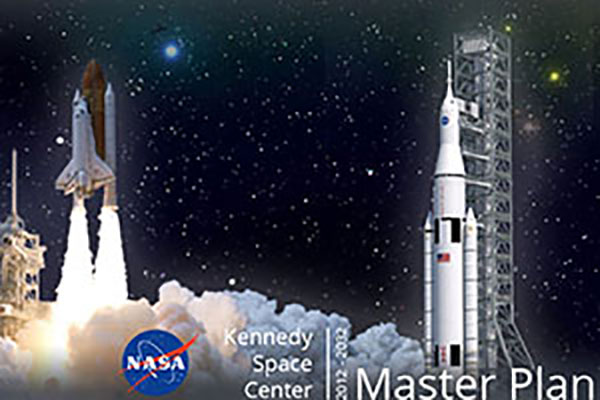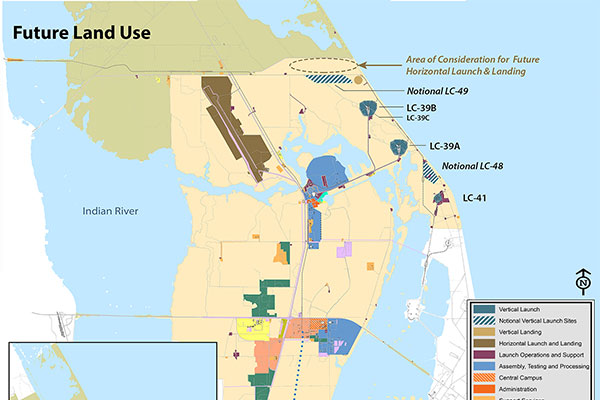
Programmatic Environmental Impact Statement (PEIS)
March 10, 2017 – NASA has issued a Record of Decision for the Kennedy Space Center (KSC), Florida, Final Programmatic Environmental Impact Statement (PEIS) to support their Center Master Plan (CMP) from 2012 to 2032.
Kennedy’s Center-Wide Operations Final Programmatic Environmental Impact Statement
Project Description
The National Aeronautics and Space Administration (NASA) prepared a Programmatic Environmental Impact Statement (PEIS) on centerwide operations at NASA’s Kennedy Space Center (KSC) in conjunction with an updated Center Master Plan (CMP) to evaluate potential environmental impacts from proposed centerwide operations and activities for a 20-year planning horizon from 2012 to 2032. The PEIS considers a range of future scenarios, from repurposing existing facilities and recapitalizing infrastructure to reorganizing Kennedy management of its land resources with various types of commercial partnerships. The PEIS is intended to ensure NASA is in compliance with applicable environmental statutes as it sets program priorities for future operations and activities.
Project Background
This Final PEIS has been prepared to evaluate the potential environmental impacts from proposed centerwide Kennedy operations, activities, and facilities for a two-decade planning horizon. These operations, activities, and facilities are described in the KSC 2012–2032 CMP, which has a planning horizon from 2012 to 2032. It considers a range of future scenarios for repurposing existing facilities and recapitalizing infrastructure, and for reorganizing the management of Kennedy and its land resources, with the potential for various kinds of partnerships (some of which are already in place). The Final PEIS is intended to ensure that NASA is in compliance with applicable environmental statutes as it sets program priorities for future operations and activities.
In the coming years, Kennedy will remain the world’s preeminent launch facility for government and commercial space access. Kennedy will support NASA, and ultimately our Nation’s competitiveness, by investing in next-generation technologies and encouraging innovation. Kennedy will foster partnerships—intergovernmental, commercial, academic, and international—to expand its ability to support both public and private space initiatives. These institutional efforts and initiatives necessitate changes to the infrastructure, facilities, and operations at Kennedy over the coming decades and are identified in a CMP update that was developed by the Center Planning and Development directorate.
The purpose of the action—the CMP—is to provide overall management guidance for Kennedy from 2012 to 2032. Implementation of the CMP will facilitate a two-decade transformation from a single, government-user launch complex to a multiuser spaceport. This multiuser spaceport will be developed in concert with NASA’s programmatic missions and requirements to explore destinations outside of low Earth orbit.
The need for the action is to update Kennedy’s CMP in a manner that supports achievement of NASA’s programmatic mission objectives while maximizing the provision of excess capabilities and assets in support of non-NASA access to space.
Overall, Kennedy is transitioning to a refocused mission that redefines its relationship with industry and leverages the potential of partnerships. Amid the challenges of an aging and unsustainable asset base and a highly constrained Federal budget, NASA must adopt and implement strategies that preserve the institutional infrastructure needed to support its purpose and programs.
In keeping with Council on Environmental Quality (CEQ) guidance, this final PEIS outlines and broadly describes actions associated with Kennedy’s proposed programs in the limited detail with which they are known at present. Three programmatic alternatives are described and their potential environmental effects are assessed in fairly general terms. At such time as a given specific project of detailed dimensions and scale is proposed at a specific location and is in the process of being reviewed and approved, this PEIS can serve as a master National Environmental Policy Act (NEPA) document to which future NEPA compliance documents may be “tiered.” That is, having already been addressed at a programmatic level, the action or project can incorporate discussion from the broader PEIS by reference and focus on the issues specific to the subsequent tiered proposal. Ideally, this will serve to expedite the environmental review process and facilitate project approval, funding, and implementation.
Notice of Intent
NASA published a Notice of Intent (NOI) to prepare a PEIS, open a public scoping period and conduct public scoping meetings in the Federal Register on May 20, 2014. The NOI is NASA’s official announcement that it will prepare an EIS for the centerwide operations at the Kennedy Space Center.
Scoping
The first public meeting was held from 5 to 8 p.m. on June 4, 2014, at the Eastern Florida State College in Titusville. The second meeting was conducted from 5 to 8 p.m. on June 5, 2014, at the New Smyrna Beach High School. The PEIS scoping period extended from May 20, 2014, to June 7, 2014. A total of 60 commenters, including 54 unique commenters, provided input during the PEIS scoping period. Commenters included Federal, state, and local agencies; non-government organizations (NGOs); and individual members of the public.
The Notice of Availability for the KSC draft PEIS was published in the Federal Register on March 4, 2016, commencing a 45-day comment period. Two well-attended public meetings were held on March 29 and March 30, 2016, at the same two venues in Titusville and New Smyrna Beach where the scoping meetings were conducted in 2014. A total of 16 individuals delivered oral comments at these two meetings, and the comments were transcribed by a court reporter. During the comment period in its entirety, written comments were received from four federal and state agencies, ten individuals, and NGOs.
Alternatives Considered
As a result of comments received during internal and external (public) scoping, NASA developed three alternatives that are assessed in this PEIS: Proposed Action, Alternative 1, and No Action. Under the first of these, the Proposed Action, KSC would transition to a multiuser spaceport. A number of new facilities would be constructed, including two seaports and horizontal and vertical launch and landing facilities. There would be changes in the acreage of designated land use categories at KSC.
Alternative 1 was crafted as a direct response to concerns expressed in comments received during the PEIS public scoping period, as well as observations and data acquired from stakeholders and other agencies during the scoping process. Under Alternative 1, as in the Proposed Action, KSC would also transition to a multiuser spaceport. Alternative 1 is similar to the Proposed Action in many regards, but differs in several key aspects: primarily, differences in the siting and size of vertical and horizontal launch and landing facilities and the elimination of two new seaports.
In the No Action Alternative, KSC management would continue its emphasis on dedicated NASA programs and would not transition in the coming years toward a multiuser spaceport. Rather, each NASA program would continue to be operated as an independent entity to a significant degree and to be funded separately, and each would manage activities and buildings in support of its own program. There would continue to be a limited non-NASA presence at KSC.
Assessment of the Analysis
The PEIS broadly predicts and describes the potential environmental consequences resulting from each of the three alternatives. There would be a number of direct and indirect adverse impacts, but none that are considered to be significantly adverse. Beneficial impacts would also occur.
Alternative 1 is NASA’s preferred alternative. It was developed as a direct response to concerns expressed during the PEIS public scoping period. Under Alternative 1, Kennedy would continue to transition to a multiuser spaceport over the coming decades, but with fewer environmental impacts than in the Proposed Action. Alternative 1 would allow for implementation of the CMP while protecting natural resources and the environment to a greater extent than the Proposed Action.
The environmentally preferred alternative is the No Action Alternative because it would avoid impacts associated with facility construction, land use changes, and the loss of natural habitats. This alternative was not selected because it would allow for neither the transition of KSC to a multiuser spaceport nor for the implementation of the CMP.
NASA HQ signed the Record of Decision (ROD) on March 10, 2017, officially designating Alternative 1 as the Kennedy PEIS preferred alternative.
Related Links:
KSC’s PEIS Record of Decision
KSC Master Plan

